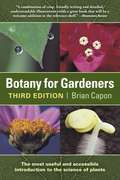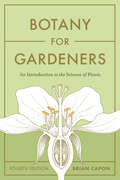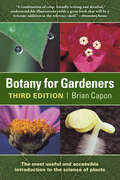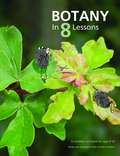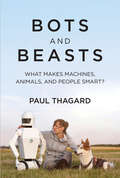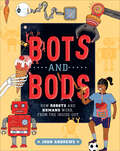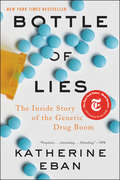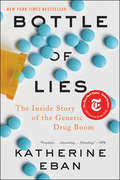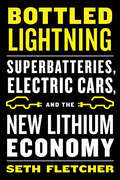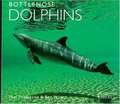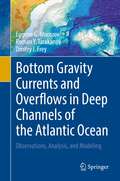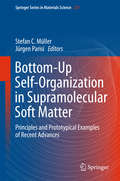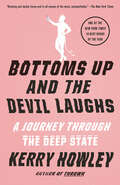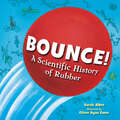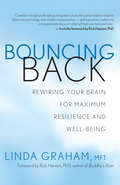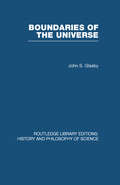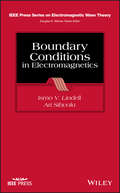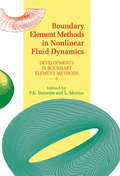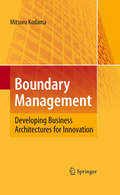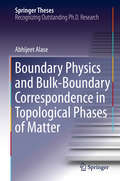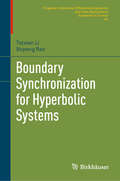- Table View
- List View
Botany for Gardeners (3rd edition)
by Brian CaponNew to the 3d edition of this well-illustrated text are four brief essays on human's relation to food, the possible impact of global warming on food supply, genetic modification of food, and the remarkable details to be seen with a scanning electron microscope. Other new additions are inset boxes expanding on the text with interesting facts and details, and additional photos. The volume, which is based on Capon's botany course for non-science majors (he is emeritus at California State U., Los Angeles) is an outstanding and enjoyable introduction to botany, whether the reader is a gardener, or just a garden visitor. Annotation ©2010 Book News, Inc., Portland, OR (booknews.com)
Botany for Gardeners, Fourth Edition: An Introduction to the Science of Plants
by Brian Capon&“This should be the cornerstone of every gardener&’s library.&” —Jeff Gillman, Director of the UNC Charlotte Botanical Gardens What happens inside a seed after it is planted? How are plants structured? How do plants reproduce? The answers to these and other questions about complex plant processes can be found in the bestselling Botany for Gardeners. First published in 1990 with more than 260,000 copies sold, it has become the go-to introduction to botany for students and gardeners. Now in its fourth edition, Botany for Gardeners has been expanded and updated. It features a revised interior, with new photos and illustrations that clarify the concepts clearer than ever before. Additional updates address scientific advances, changes in nomenclature and taxonomy, and more. As before, Botany for Gardeners shares accessible information about how plants are organized, how they have adapted to nearly all environments on earth, their essential functions, and how they reproduce.
Botany for Gardeners: Third Edition (Science For Gardeners Ser.)
by Brian CaponA bestseller since its debut in 1990, this indispensable and handy reference has now been expanded and updated to include an appendix on plant taxonomy and a comprehensive index. Two dozen new photos and illustrations make this new edition even richer with information. Its convenient paperback format makes it easy to carry and access, whether you are in or out of the garden. An essential overview of the science behind plants for beginning and advanced gardeners alike.
Botany in 8 Lessons: A Complete Curriculum for Ages 8-14
by Ellen MchenryA complete botany curriculum for ages 9-14 (grades 4-8 in the USA). Includes a 100-page student text plus a 150-page teacher's section. The student text is written in a lively, engaging style, often with a touch of whimsical humor, yet delves deeply into the science of how plants work. Each chapter ends with some follow-up activities such as word puzzles, quiz questions, and links to videos that illustration the concepts learned in the text. The teacher's section includes patterns and instructions for board games, group games, active games, art and craft activities, experiments, and even two songs. Ideal for homeschool or gifted education, but also a great resource for any classroom.
Botrytis - the Fungus, the Pathogen and its Management in Agricultural Systems
by Sabine Fillinger Yigal EladThe fungal genus Botrytis is the focus of intensive scientific research worldwide. The complex interactions between this pathogen and the plants it infects and the economic importance of the diseases caused by Botrytis (principally grey mould) on more than 1400 species of cultivated plants pre- and post-harvest, render this pathogen of particular interest to farmers, advisers, students and researchers in many fields worldwide. This 20-chapter book is a comprehensive treatise covering the rapidly developing science of Botrytis and reflecting the major developments in studies of this fungus. It will serve as a source of general information for specialists in agriculture and horticulture, and also for students and scientists interested in the biology of this fascinating, multifaceted phytopathogenic fungal species.
Bots and Beasts: What Makes Machines, Animals, and People Smart?
by Paul ThagardAn expert on mind considers how animals and smart machines measure up to human intelligence.Octopuses can open jars to get food, and chimpanzees can plan for the future. An IBM computer named Watson won on Jeopardy! and Alexa knows our favorite songs. But do animals and smart machines really have intelligence comparable to that of humans? In Bots and Beasts, Paul Thagard looks at how computers ("bots") and animals measure up to the minds of people, offering the first systematic comparison of intelligence across machines, animals, and humans. Thagard explains that human intelligence is more than IQ and encompasses such features as problem solving, decision making, and creativity. He uses a checklist of twenty characteristics of human intelligence to evaluate the smartest machines--including Watson, AlphaZero, virtual assistants, and self-driving cars--and the most intelligent animals--including octopuses, dogs, dolphins, bees, and chimpanzees. Neither a romantic enthusiast for nonhuman intelligence nor a skeptical killjoy, Thagard offers a clear assessment. He discusses hotly debated issues about animal intelligence concerning bacterial consciousness, fish pain, and dog jealousy. He evaluates the plausibility of achieving human-level artificial intelligence and considers ethical and policy issues. A full appreciation of human minds reveals that current bots and beasts fall far short of human capabilities.
Bots and Bods: How Robots and Humans Work, from the Inside Out
by John AndrewsBots and Bods is an illustrated guide for kids looking to explore anatomy and technology and how they're related. How do we both move or sense the world? How does robot intelligence compare to our own? Middle-grade readers will find these answers and more among the four sections:Body structuresMuscle and movementSenses and sensorsThinking and feelingAn accessible guide with exciting illustrations, fun facts, and special feature spreads about robots in the real world explains why &“bots&” can sometimes do a better job than &“bods&” and vice versa.
Bottle of Lies: The Inside Story of the Generic Drug Boom
by Katherine EbanFrom an award-winning journalist, an explosive narrative investigation of the generic drug boom that reveals fraud and life-threatening dangers on a global scale—The Jungle for pharmaceuticalsMany have hailed the widespread use of generic drugs as one of the most important public-health developments of the twenty-first century. Today, almost 90 percent of our pharmaceutical market is comprised of generics, the majority of which are manufactured overseas. We have been reassured by our doctors, our pharmacists and our regulators that generic drugs are identical to their brand-name counterparts, just less expensive. But is this really true?Katherine Eban’s Bottle of Lies exposes the deceit behind generic-drug manufacturing—and the attendant risks for global health. Drawing on exclusive accounts from whistleblowers and regulators, as well as thousands of pages of confidential FDA documents, Eban reveals an industry where fraud is rampant, companies routinely falsify data, and executives circumvent almost every principle of safe manufacturing to minimize cost and maximize profit, confident in their ability to fool inspectors. Meanwhile, patients unwittingly consume medicine with unpredictable and dangerous effects.The story of generic drugs is truly global. It connects middle America to China, India, sub-Saharan Africa and Brazil, and represents the ultimate litmus test of globalization: what are the risks of moving drug manufacturing offshore, and are they worth the savings? A decade-long investigation with international sweep, high-stakes brinkmanship and big money at its core, Bottle of Lies reveals how the world’s greatest public-health innovation has become one of its most astonishing swindles.
Bottle of Lies: The Inside Story of the Generic Drug Boom
by Katherine EbanA NEW YORK TIMES BESTSELLER New York Times 100 Notable Books of 2019New York Public Library Best Books of 2019 Kirkus Reviews Best Health and Science Books of 2019Science Friday Best Books of 2019 New postscript by the authorFrom an award-winning journalist, an explosive narrative investigation of the generic drug boom that reveals fraud and life-threatening dangers on a global scale—The Jungle for pharmaceuticalsMany have hailed the widespread use of generic drugs as one of the most important public-health developments of the twenty-first century. Today, almost 90 percent of our pharmaceutical market is comprised of generics, the majority of which are manufactured overseas. We have been reassured by our doctors, our pharmacists and our regulators that generic drugs are identical to their brand-name counterparts, just less expensive. But is this really true?Katherine Eban’s Bottle of Lies exposes the deceit behind generic-drug manufacturing—and the attendant risks for global health. Drawing on exclusive accounts from whistleblowers and regulators, as well as thousands of pages of confidential FDA documents, Eban reveals an industry where fraud is rampant, companies routinely falsify data, and executives circumvent almost every principle of safe manufacturing to minimize cost and maximize profit, confident in their ability to fool inspectors. Meanwhile, patients unwittingly consume medicine with unpredictable and dangerous effects.The story of generic drugs is truly global. It connects middle America to China, India, sub-Saharan Africa and Brazil, and represents the ultimate litmus test of globalization: what are the risks of moving drug manufacturing offshore, and are they worth the savings? A decade-long investigation with international sweep, high-stakes brinkmanship and big money at its core, Bottle of Lies reveals how the world’s greatest public-health innovation has become one of its most astonishing swindles.
Bottled Lightning: Superbatteries, Electric Cars, and the New Lithium Economy
by Seth FletcherLithium batteries may hold the key to an environmentally sustainable, oil-independent future. From electric cars to a "smart" power grid that can actually store electricity, letting us harness the powers of the sun and the wind and use them when we need them, lithium—a metal half as dense as water, found primarily in some of the most uninhabitable places on earth—has the potential to set us on a path toward a low-carbon energy economy. In Bottled Lightning, the science reporter Seth Fletcher takes us on a fascinating journey, from the salt flats of Bolivia to the labs of MIT and Stanford, from the turmoil at GM to cutting-edge lithium-ion battery start-ups, introducing us to the key players and ideas in an industry with the power to reshape the world. Lithium is the thread that ties together many key stories of our time: the environmental movement; the American auto industry, staking its revival on the electrification of cars and trucks; the struggle between first-world countries in need of natural resources and the impoverished countries where those resources are found; and the overwhelming popularity of the portable, Internet-connected gadgets that are changing the way we communicate. With nearly limitless possibilities, the promise of lithium offers new hope to a foundering American economy desperately searching for a green-tech boom to revive it.
Bottlenose Dolphins (WorldLife Library)
by Paul Thompson Ben WilsonIntelligent, graceful and approachable, dolphins have long been among the worlds favorite sea creatures. Of all the dolphin species, the bottlenose is best known and loved. But bottlenose dolphins are more than television stars and aquarium performers. In Bottlenose Dolphins readers will voyage under the sea with researchers Paul Thompson and Ben Wilson, who are studying dolphins off the coast of Scotland. The authors explain the bottlenose dolphins oceanic habitat and range, and delve into their complex social relationships. They also share their concerns for the future of these beloved seafarers and suggest steps to protect them. Stunning color photographs accompany their insights.
Bottom Gravity Currents and Overflows in Deep Channels of the Atlantic Ocean: Observations, Analysis, and Modeling
by Eugene G. Morozov Roman Y. Tarakanov Dmitry I. FreyThis book is dedicated to the analysis of bottom waters flows through underwater channels of the Atlantic Ocean. The study is based on recent observations of the authors, analysis of historical data, numerical modeling, and literature review. For example, studying both the measurements from the World Ocean Circulation experiment in the 1990s and recent measurements reveals the decadal variations of water properties in the ocean.Seawater is cooled at high latitudes, descends to the ocean bottom, and slowly flows to the tropical latitudes and further. This current is slow in the deep basins, but intensifies in the abyssal channels connecting the basins. The current overflows submarine topographic structures and sometimes forms deep cataracts when water descends over slopes by several hundred meters. The flow of Antarctic Bottom Water (AABW) is studied on the basis of CTD sections combined with Lowered Acoustic Doppler Profiling (LADCP) carried out annually, and long-term moored measurements of currents. This book is a collection of oceanographic data, interpretation, and analysis, which can be used by field oceanographers, specialists in numerical modeling, and students who specialize in oceanography.
Bottom-Up Self-Organization in Supramolecular Soft Matter: Principles and Prototypical Examples of Recent Advances (Springer Series in Materials Science #217)
by Stefan C. Müller Jürgen ParisiThis book presents the general concepts of self-organized spatio-temporal ordering processes. These concepts are demonstrated via prototypical examples of recent advances in materials science. Particular emphasis is on nano scale soft matter in physics, chemistry, biology and biomedicine. The questions addressed embrace a broad spectrum of complex nonlinear phenomena, ranging from self-assembling near the thermodynamical equilibrium to dissipative structure formation far from equilibrium. Their mutual interplay gives rise to increasing degrees of hierarchical order. Analogues are pointed out, differences characterized and efforts are made to reveal common features in the mechanistic description of those phenomena.
Bottoms Up and the Devil Laughs: A Journey Through the Deep State
by Kerry HowleyA NATIONAL BOOK CRITICS CIRCLE AWARD FINALIST • A NEW YORK TIMES TOP TEN BOOK OF THE YEAR • A VANITY FAIR BEST BOOK OF THE YEAR&“Riveting and darkly funny and in all senses of the word, unclassifiable.&” – The New York TimesA wild, humane, and hilarious meditation on post-privacy America—from the acclaimed author of ThrownWho are you? You are data about data. You are a map of connections—a culmination of everything you have ever posted, searched, emailed, liked, and followed. In this groundbreaking work of narrative nonfiction, Kerry Howley investigates the curious implications of living in the age of the indelible. Bottoms Up and the Devil Laughs tells the true story of intelligence specialist Reality Winner, a lone young woman who stuffs a state secret under her skirt and trusts the wrong people to help. After printing five pages of dangerous information she was never supposed to see, Winner finds herself at the mercy of forces more invasive than she could have possibly imagined.Following Winner&’s unlikely journey from rural Texas to a federal courtroom, Howley maps a hidden world, drawing in John Walker Lindh, Lady Gaga, Edward Snowden, a rescue dog named Outlaw Babyface Nelson, and a mother who will do whatever it takes to get her daughter out of jail. Howley&’s subjects face a challenge new to history: they are imprisoned by their past selves, trapped for as long as the Internet endures. A soap opera set in the deep state, Bottoms Up and the Devil Laughs is a free fall into a world where everything is recorded and nothing is sacred, from a singular writer unafraid to ask essential questions about the strangeness of modern life.
Bounce!: A Scientific History of Rubber
by Sarah AlbeeEver wondered what makes rubber bounce? Or why it's stretchy? And WHY is rubber so . . . rubbery?! Learn the facinating science and history behind this ubiquitous material!With sidebars, graphics, fun facts, and more, the history of rubber reveals plenty of fascinating secrets and surprises. Elementary school readers will discover that early balls didn't bounce; that people in the rainforest made waterproof gear from rubber thousands of years before Europeans got into the act; and that sneakers, bicycles, and cars created demand for more and more rubber!Back matter includes a time line and a bit about the complicated implications of harvesting rubber.
Bouncing Back: Rewiring Your Brain for Maximum Resilience and Well-Being
by Linda GrahamResilience is the ability to face and handle life’s challenges, whether everyday disappointments or extraordinary disasters. While resilience is innate in the brain, over time we learn unhelpful patterns, which then become fixed in our neural circuitry. But science is now revealing that what previously seemed hardwired can be rewired, and Bouncing Back shows us how. With powerful, time-tested exercises, Linda Graham guides us in rebuilding our core well-being and disaster-proofing our brains.
Boundaries of a Complex World (Springer Series in Synergetics)
by Andrei LuduThe 2nd edition of this book provides novel topics and studyies in boundaries of networks and Big Data Systems.The central theme of this book is the extent to which the structure of the free dynamical boundaries of a system controls the evolution of the system as a whole. Applying three orthogonal types of thinking - mathematical, constructivist and morphological, it illustrates these concepts using applications to selected problems from the social and life sciences, as well as economics. In a broader context, it introduces and reviews some modern mathematical approaches to the science of complex systems. Standard modeling approaches (based on non-linear differential equations, dynamic systems, graph theory, cellular automata, stochastic processes, or information theory) are suitable for studying local problems. However they cannot simultaneously take into account all the different facets and phenomena of a complex system, and new approaches are required to solve the challenging problem of correlations between phenomena at different levels and hierarchies, their self-organization and memory-evolutive aspects, the growth of additional structures and are ultimately required to explain why and how such complex systems can display both robustness and flexibility. This graduate-level text addresses a broader interdisciplinary audience, keeping the mathematical level essentially uniform throughout the book, and involving only basic elements from calculus, algebra, geometry and systems theory.
Boundaries of the Universe (Routledge Library Editions: History & Philosophy of Science)
by John S GlasbyThe boundaries of space exploration are being pushed back constantly, but the realm of the partially understood and the totally unknown is as great as ever. Among other things this book deals with astronomical instruments and their application, recent discoveries in the solar system, stellar evolution, the exploding starts, the galaxies, quasars, pulsars, the possibilities of extraterrestrial life and relativity.
Boundary Conditions in Electromagnetics (IEEE Press Series on Electromagnetic Wave Theory)
by Ismo V. Lindell Ari SihvolaA comprehensive survey of boundary conditions as applied in antenna and microwave engineering, material physics, optics, and general electromagnetics research. Boundary conditions are essential for determining electromagnetic problems. Working with engineering problems, they provide analytic assistance in mathematical handling of electromagnetic structures, and offer synthetic help for designing new electromagnetic structures. Boundary Conditions in Electromagnetics describes the most-general boundary conditions restricted by linearity and locality, and analyzes basic plane-wave reflection and matching problems associated to a planar boundary in a simple-isotropic medium. This comprehensive text first introduces known special cases of particular familiar forms of boundary conditions — perfect electromagnetic conductor, impedance, and DB boundaries — and then examines various general forms of boundary conditions. Subsequent chapters discuss sesquilinear boundary conditions and practical computations on wave scattering by objects defined by various boundary conditions. The practical applications of less-common boundary conditions, such as for metamaterial and metasurface engineering, are referred to throughout the text. This book: Describes the mathematical analysis of fields associated to given boundary conditions Provides examples of how boundary conditions affect the scattering properties of a particle Contains ample in-chapter exercises and solutions, complete references, and a detailed index Includes appendices containing electromagnetic formulas, Gibbsian 3D dyadics, and four-dimensional formalism Boundary Conditions in Electromagnetics is an authoritative text for electrical engineers and physicists working in electromagnetics research, graduate or post-graduate students studying electromagnetics, and advanced readers interested in electromagnetic theory.
Boundary Element Methods in Nonlinear Fluid Dynamics: Developments in boundary element methods - 6
by P. K. Banerjee L. MorinoThis volume demonstrates that boundary element methods are both elegant and efficient in their application to time dependent time harmonic problems in engineering and therefore worthy of considerable development.
Boundary Management: Developing Business Architectures for Innovation
by Mitsuru KodamaThis book presents the concept of business architecture and optimizing processes as a corporate system based on multiple corporate case studies, including Sony, NTT-DATA, NTT-DoCoMo, Toyota, Honda, Omron, Takara, Recruit, First Retailing, Panasonic and Canon.
Boundary Physics and Bulk-Boundary Correspondence in Topological Phases of Matter (Springer Theses)
by Abhijeet AlaseThis thesis extends our understanding of systems of independent electrons by developing a generalization of Bloch’s Theorem which is applicable whenever translational symmetry is broken solely due to arbitrary boundary conditions. The thesis begins with a historical overview of topological condensed matter physics, placing the work in context, before introducing the generalized form of Bloch's Theorem. A cornerstone of electronic band structure and transport theory in crystalline matter, Bloch's Theorem is generalized via a reformulation of the diagonalization problem in terms of corner-modified block-Toeplitz matrices and, physically, by allowing the crystal momentum to take complex values. This formulation provides exact expressions for all the energy eigenvalues and eigenstates of the single-particle Hamiltonian. By precisely capturing the interplay between bulk and boundary properties, this affords an exact analysis of several prototypical models relevant to symmetry-protected topological phases of matter, including a characterization of zero-energy localized boundary excitations in both topological insulators and superconductors. Notably, in combination with suitable matrix factorization techniques, the generalized Bloch Hamiltonian is also shown to provide a natural starting point for a unified derivation of bulk-boundary correspondence for all symmetry classes in one dimension.
Boundary Plasma Physics: An Accessible Guide to Transport, Detachment, and Divertor Design (Springer Series on Atomic, Optical, and Plasma Physics #123)
by Fulvio MilitelloThis book serves as an introduction to boundary plasma physics, providing an accessible entry point to the topic of plasma exhaust in magnetic confinement devices. While it delivers a concise, rigorous, and comprehensive account of all the major scientific topics relevant to those working on the subject, it also remains accessible and easy to consult due to its modular and compact structure. Beginning with the basic kinetic and fluid descriptions of plasma, and advancing through plasma-surface interactions, filamentary transport and plasma detachment, to conclude with a discussion of divertor configurations, this book represents a necessary and timely addition to the literature on the fast-growing field of boundary plasma physics. It will appeal to experienced theoreticians or experimentalists looking to enter the field as well as graduate students wishing to learn about it.
Boundary Synchronization for Hyperbolic Systems (Progress in Nonlinear Differential Equations and Their Applications #94)
by Tatsien Li Bopeng RaoWithin this carefully presented monograph, the authors extend the universal phenomenon of synchronization from finite-dimensional dynamical systems of ordinary differential equations (ODEs) to infinite-dimensional dynamical systems of partial differential equations (PDEs). By combining synchronization with controllability, they introduce the study of synchronization to the field of control and add new perspectives to the investigation of synchronization for systems of PDEs. With a focus on synchronization for a coupled system of wave equations, the text is divided into three parts corresponding to Dirichlet, Neumann, and coupled Robin boundary controls. Each part is then subdivided into chapters detailing exact boundary synchronization and approximate boundary synchronization, respectively. The core intention is to give artificial intervention to the evolution of state variables through appropriate boundary controls for realizing the synchronization in a finite time, creating a novel viewpoint into the investigation of synchronization for systems of partial differential equations, and revealing some essentially dissimilar characteristics from systems of ordinary differential equations. Primarily aimed at researchers and graduate students of applied mathematics and applied sciences, this text will particularly appeal to those interested in applied PDEs and control theory for distributed parameter systems.
Boundary Value Problems for Linear Partial Differential Equations
by Manuel Mañas Luis Martínez AlonsoBoundary value problems play a significant role in modeling systems characterized by established conditions at their boundaries. On the other hand, initial value problems hold paramount importance in comprehending dynamic processes and foreseeing future behaviors. The fusion of these two types of problems yields profound insights into the intricacies of the conduct exhibited by many physical and mathematical systems regulated by linear partial differential equations.Boundary Value Problems for Linear Partial Differential Equations provides students with the opportunity to understand and exercise the benefits of this fusion, equipping them with realistic, practical tools to study solvable linear models of electromagnetism, fluid dynamics, geophysics, optics, thermodynamics and specifically, quantum mechanics. Emphasis is devoted to motivating the use of these methods by means of concrete examples taken from physical models. Features No prerequisites apart from knowledge of differential and integral calculus and ordinary differential equations. Provides students with practical tools and applications Contains numerous examples and exercises to help readers understand the concepts discussed in the book.
